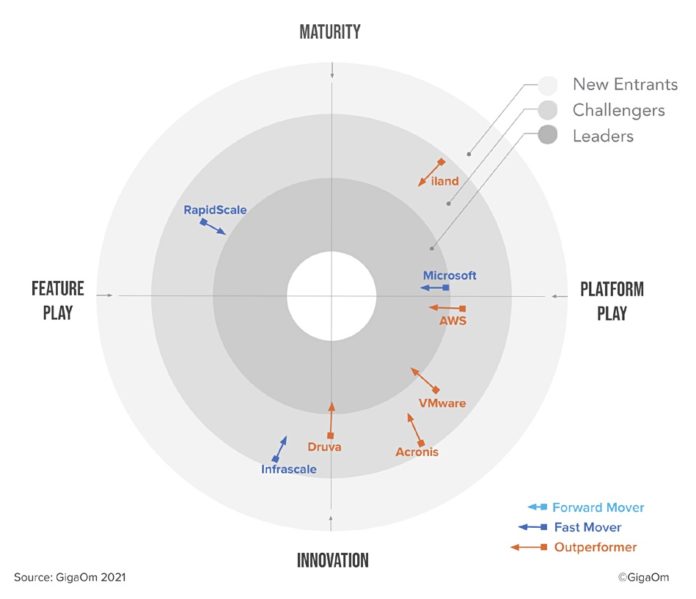Research house GigaOm has published a Radar report on Disaster Recovery-as-a-Service (DRaaS) suppliers, saying the industry is young but oldster Microsoft is in the lead.
DRaaS is the provision of off-site disaster recovery facilities from a public cloud-delivered service instead of from a DR system hosted on the main and recovery datacentres. When a disaster strikes, the system is failed over to a recovery site which is typically hosted in a public cloud but could also be in a remote site. It fails back to the original site when it is operational once more. The DRaaS supplier has to look after copying new data to the recovery site and provide the failover and failback processes.
Analyst Alistair Cooke writes: “The market is still young, with plenty of space for vendors to enhance their positions.” He has evaluated eight vendors: Acronis, AWS, Druva, iland, Infrascale, Microsoft (Azure), RapidScale and VMware.
Cooke analysed their services using a set of key criteria and their impact on evaluation metrics to produce a Radar graphic — a forward-looking perspective on all the vendors in the report, based on their products’ technical capabilities and feature sets.

We see one Leader — Microsoft (Azure) — with all the other suppliers regarded as Challengers. There are no new entrants and AWS, Druva and VMware are moving into the Leaders’ ring.
He writes: “The multi-purpose cloud platform vendors (AWS, Azure, and iland) offer multi-tenant disaster recovery with consumption-based pricing, so monthly costs vary depending on the amount of DR test and recovery activity undertaken. More specialised data protection providers, such as Acronis, Druva, and Infrascale, might provide more mature recovery methodologies due to their focus.”
Cooke highlights: “The lack of built-in DR orchestration from the two big cloud providers (AWS and Azure) stands out against the other great capabilities both platforms provide. We were also surprised by the progress Druva has made in the past couple of years, in particular how feature-packed its DRaaS service is.”
Supplier extracts from the report
“Acronis Cyber Protect Cloud DRaaS capabilities are a good fit for the smaller organisations that Acronis designed them to suit.” But there is not yet any automated script execution capability.
AWS Cloud Endure Disaster Recovery provides agent-based replication and recovery from physical, virtual, or cloud-based systems into an AWS Virtual Private Cloud (VPC) with down to sub-second RPO. But “there seems to be no built-in capability to sequence the starting of multiple VMs or to use scripts to initiate VMs.”
“Druva does not attempt to reach the lowest possible RTO/RPO, recognising that Tier-0 applications are better deployed as active-active geo-clustered configurations. Druva simply wants to protect every other application and machine in your estate.”
“The iland Secure Disaster Recovery as a Service can be implemented with either Veeam or Zerto supplying the underlying protection.” We note that HPE has bought Zerto and is expected to offer Zerto technology as-a-service through its GreenLake operation. There are no iland egress charges by the way.
“The Infrascale Backup and Disaster Recovery Cloud (IBDR-Cloud) service … uses an on-premises appliance for local recovery. The appliance provides self-contained storage and compute capabilities to allow on-premises recovery if, for example, your storage array fails.”
“Microsoft Azure Site Recovery (ASR) provides DRaaS from on-premises into an Azure region, or from one Azure zone or region to another. … Orchestration and automation are strong in ASR, with customers able to choose from a variety of automation tools including Microsoft PowerShell, ARM templates, Azure policies, and third-party tools such as Terraform and Ansible.”
“RapidScale Cloud Recovery provides disaster recovery using the technologies from RapidScale Backup-as-a-Service (BaaS), Infrastructure-as-a-Service (IaaS), and Zerto, combined with some automation and orchestration.” It uses continuous data protection technology, which can have a NetApp array as a target, and has a short RPO.
“The VMware Cloud Disaster Recovery (VCDR) service allows any vSphere-based VMs to be protected and recovered to the VMware Cloud on AWS (VMC). As VCDR is a first-party product, integration into vSphere and VMC is very tight, but there’s no protection for other hypervisors or physical hosts.”
Find out more about the GigaOm Radar for Disaster Recovery-as-a-Service here.








